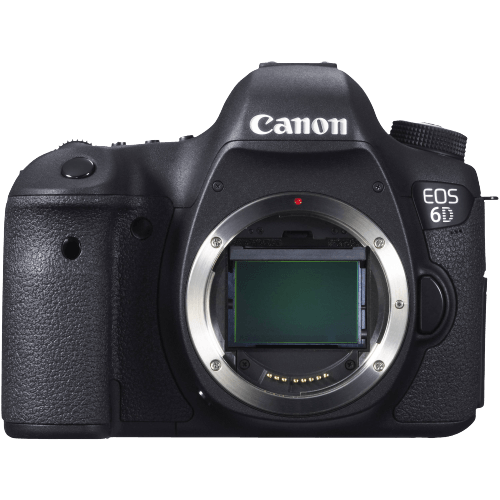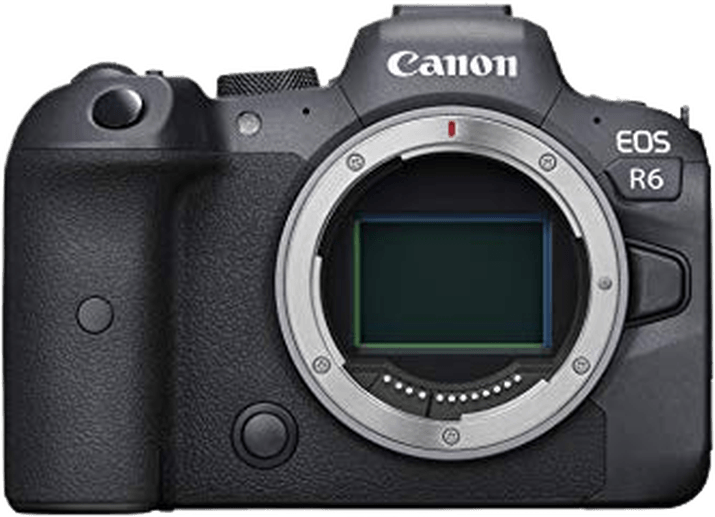Canon EOS 6D vs EOS R6 Comparison
Canon EOS 6D

Canon EOS R6

The Canon EOS R6 outperforms the Canon EOS 6D with a score of 80/100 compared to 59/100. Both cameras share some common specifications, such as being from the same manufacturer and having a similar launch price range. However, the EOS R6 is a mirrorless camera released in 2020, while the EOS 6D is a DSLR from 2012.
The EOS R6 is superior due to its lighter weight of 680g, compared to the EOS 6D’s 770g, and its more compact size, measuring 138 x 98 x 88mm against the EOS 6D’s 145 x 111 x 71mm. These features make it more portable and convenient for photographers.
The EOS 6D has its merits as well, such as a lower launch price of $2099 compared to the EOS R6’s $2499. This may appeal to budget-conscious buyers. However, its older technology and lower score make it less competitive than the EOS R6.
Taking all these factors into account, the Canon EOS R6 emerges as the superior choice due to its higher score, more advanced technology, and better portability.
Canon EOS 6D vs EOS R6 Overview and Optics
The Canon EOS R6 emerges as the winner in the optics comparison, scoring 79/100, while the Canon EOS 6D scores 61/100. Both cameras share several specifications, such as the 20.1 and 20.2 megapixels, respectively, the CMOS sensor type, and full-frame sensor size. However, the EOS R6 outperforms the EOS 6D in several areas, making it the superior choice for optics.
The EOS R6 benefits from a faster shooting speed of 20, compared to the EOS 6D’s 4.5, enabling the capture of more images in a shorter time frame. Additionally, the EOS R6 has a newer and more advanced processor, the Digic X, providing better image processing capabilities than the EOS 6D’s Digic 5+ processor. The R6 also has a higher DXOMARK score for the sensor, 90, indicating improved overall image quality over the 6D’s score of 82.
The lens mount on the EOS R6 is the Canon RF, which supports a wider range of modern lenses, while the EOS 6D uses the older Canon EF mount. Furthermore, the R6 offers image stabilization, which the 6D lacks, reducing the chances of blurred images due to camera shake.
The EOS 6D, however, has a slight advantage in megapixels, with 20.2 compared to the R6’s 20.1. This minor difference is unlikely to have a significant impact on image quality but is still worth noting.
Considering the faster shooting speed, better processor, higher DXOMARK sensor score, more advanced lens mount, and image stabilization, the Canon EOS R6 is the clear choice for superior optics. The EOS 6D, with its slightly higher megapixels, may still appeal to some users, but the overall advantages of the R6 make it the better option.
Canon EOS 6D vs EOS R6 Video Performance
The Canon EOS R6 outperforms the Canon EOS 6D in video capabilities with a significant difference in scores, 91/100 for the R6 and 43/100 for the 6D. Both cameras share some common specs, but the R6 has superior features that justify its higher score.
The shared specs between the two cameras include the ability to record video and adjust settings such as exposure and focus. However, the R6 surpasses the 6D in various aspects. It offers 4K video resolution, while the 6D only provides Full HD. The R6 also has a max video dimension of 3840 x 2160, compared to the 6D’s 1920 x 1080. Additionally, the R6 has a maximum video frame rate of 120fps, whereas the 6D is limited to 30fps. The R6’s built-in time-lapse functionality is another advantage over the 6D, which lacks this feature.
The 6D has no specific advantage over the R6 in terms of video capabilities. The R6’s higher score reflects its superiority in providing better video quality, resolution, and versatility. The 6D falls short in these areas, making it a less desirable choice for videographers.
The Canon EOS R6 is the clear winner when comparing video capabilities with the Canon EOS 6D. The R6’s higher score is a result of its better video resolution, dimensions, frame rate, and time-lapse functionality. The 6D, on the other hand, offers no advantages in these areas. Those who prioritize video performance should opt for the Canon EOS R6, while the 6D may be suitable for those with less demanding video requirements.
Canon EOS 6D vs EOS R6 Features and Benefits
The Canon EOS R6 emerges as the winner in this comparison, with a feature score of 85/100, while the Canon EOS 6D has a lower score of 57/100. Both cameras share some specifications, including a 3-inch screen size, and WIFI capabilities.
The Canon EOS R6 outperforms the 6D in several aspects. Its screen resolution is significantly higher, at 1,620,000 dots compared to the 6D’s 1,040,000 dots. This results in a sharper and clearer display. The R6 also has a touchscreen, making it more user-friendly and efficient for menu navigation and settings adjustments. Additionally, the R6 features a flip screen, which is helpful for capturing images and videos from various angles. Furthermore, the R6 is equipped with Bluetooth connectivity, allowing for seamless pairing with compatible devices and remote control functionality.
On the other hand, the Canon EOS 6D has GPS functionality, which the R6 lacks. This feature enables the 6D to geotag images with location data, making it easier to organize and locate photos based on where they were taken.
Despite the 6D’s advantage in GPS functionality, the R6’s superior screen resolution, touchscreen, flip screen, and Bluetooth capabilities contribute to its higher feature score. The Canon EOS R6’s enhanced features make it a more versatile and user-friendly camera, while the 6D’s GPS function may appeal to photographers who prioritize geotagging.
Canon EOS 6D vs EOS R6 Storage and Battery
The Canon EOS R6 outperforms the Canon EOS 6D in storage and battery, scoring 68/100 compared to the 6D’s 45/100. Both cameras have common features, including support for SD, SDHC, and SDXC memory cards. However, the R6 has a significant advantage with two memory card slots and compatibility with faster UHS-II cards.
The EOS 6D’s strength lies in its battery life, providing 1090 shots with the LP-E6 battery, whereas the R6 offers only 360 shots using the LP-E6NH battery. Despite this, the R6 compensates with USB charging capability, giving users added convenience.
Given these factors, the Canon EOS R6 emerges as the superior choice for storage and battery, with its dual card slots and USB charging capabilities. The EOS 6D, while offering impressive battery life, lacks these modern features, making the R6 a more versatile option.
Canon EOS 6D vs EOS R6 – Our Verdict
Are you still undecided about which camera is right for you? Have a look at these popular comparisons that feature the Canon EOS 6D or the Canon EOS R6:

